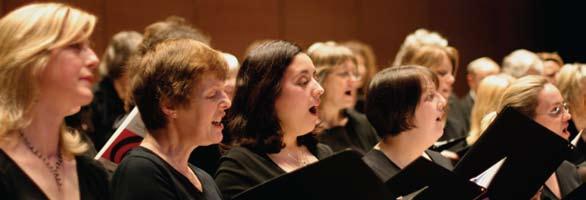
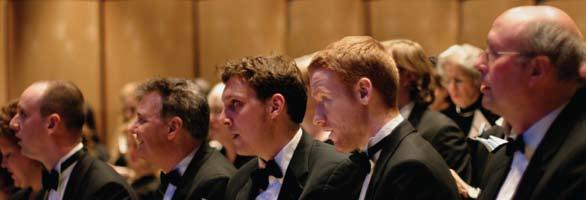
Hong Kong Philharmonic Orchestra


藝術總監 Artistic Director
尼威爾.克里特
Neville Creed



Hong Kong Philharmonic Orchestra


藝術總監 Artistic Director
尼威爾.克里特
Neville Creed
8 倫敦愛樂合唱團 London Philharmonic Choir
23.2.2008
10 曲目及演出者 Programme and Credits
13 艾度.迪華特 Edo de Waart
15 香港管弦樂團 Hong Kong Philharmonic Orchestra
16 歌唱家簡歷 Soloists’ Biographies
18 樂曲介紹 Programme Notes
26 歌詞 Lyrics
24.2.2008
36 曲目及演出者 Programme and Credits
39 尼威爾.克里特 Neville Creed
41 伊安.法林頓 Iain Farrington
42 樂曲介紹 Programme Notes
48 歌詞 Lyrics
55
56
Choir Members
Orchestra Members
為了讓大家對這次演出留下美好的印象,請切記在節目開始前關掉手錶、 無綫電話及傳呼機的響鬧裝置。會場內請勿擅自攝影、錄音或錄影,亦不 可飲食和吸煙,多謝合作。
To make this performance a pleasant experience for the artists and other members of the audience, PLEASE switch off your alarm watches, MOBILE PHONES and PAGERS. Eating and drinking, unauthorised photography and audio or video recording are forbidden in the auditorium. Thank you for your co-operation.
23- 24.2.2008
香港文化中心音樂廳
Concert Hall
Hong Kong Cultural Centre
演出長約1小時45分鐘,包括一節20分鐘 中場休息
Running time: approximately 1 hour and 45 minutes with a 20 minute interval

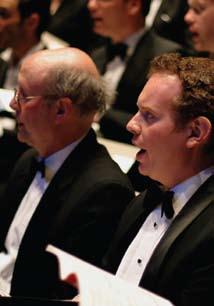
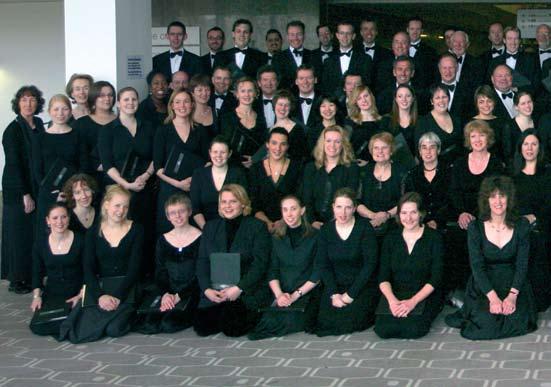
倫敦愛樂合唱團於 1947 年成立,被譽認為英 國最傑出的合唱團之一,廣受樂評讚賞。數十 年來,合唱團已出版八十多個錄音,並曾與多 位首屈一指的指揮合作。
合唱團與倫敦愛樂樂團合作無間,定期參與樂
團在倫敦和各地的演出,這個樂季的演出, 包括尤洛夫斯基指揮的馬勒《悲傷之歌》、絲 蒙.揚指揮的馬勒第二交響曲,以及馬克.艾
達指揮,紀念艾爾加誕辰150 周年的音樂會。
在2008年4月,合唱團將與尤洛夫斯基和倫敦 愛樂攜手,在倫敦皇家節慶音樂廳演出大型製
作 ── 威爾第的《安魂曲》。
倫敦愛樂合唱團也與多個頂尖管弦樂團和組合 合作,又曾參與2007年7月倫敦城市藝術節的 閉幕音樂會,與倫敦交響樂團暨合唱團,在聖 保祿大教堂演出貝遼士的《安魂彌撒曲》。
合唱團經常外訪,曾於2005年6月在吉隆坡、
柏斯舉行音樂會;又多次到歐洲各地演出,包 括在馬素爾的帶領下,與倫敦愛樂樂團到訪 雅典和琉森; 2004 年在香港演出兩場海頓的 《創世記》,寫下佳績,今年合唱團欣然重 臨,參與香港藝術節。
合唱團正慶祝成立 60 周年,並已出版新書 《哈利路亞:倫敦愛樂合唱團外史》,以茲 紀念。
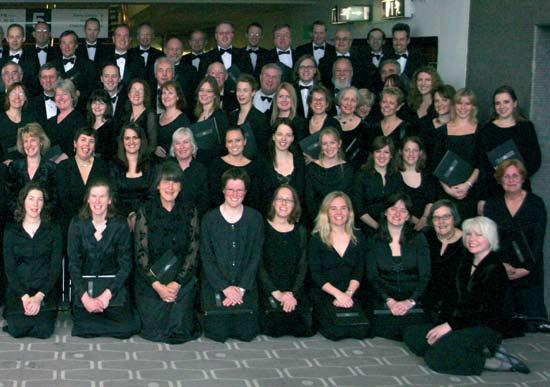
Founded in 1947 the London Philharmonic Choir is widely regarded as one of the UK’s finest choirs, consistently meeting with high critical acclaim. Throughout its history, it has made over 80 recordings and performed under many of the world’s greatest conductors.
The Choir enjoys a close relationship with the London Philharmonic Orchestra, joining it regularly for concerts in London and further afield. Recent performances together include Mahler’s Das klagende Lied conducted by Vladimir Jurowski; Mahler’s Symphony No 2 under Simone Young; and a concert conducted by Mark Elder to celebrate the 150th anniversary of Edward Elgar’s birth. The Choir will join Vladimir Jurowski and the London Philharmonic Orchestra for a large - scale performance of Verdi’s Requiem in the Royal Festival Hall in April 2008.
The London Philharmonic Choir also works with many other leading orchestras and ensembles. In July 2007 it took part in Berlioz’s Grande messe des morts with the London Symphony Orchestra and Chorus in St Paul’s Cathedral, for the closing concert of the City of London Festival.
The Choir often travels overseas and in June 2005 gave concerts in Kuala Lumpur and Perth. It has made several visits to other parts of Europe including performances in Athens and Lucerne with the London Philharmonic Orchestra under Kurt Masur. Having given two successful performances of Haydn’s The Creation in Hong Kong in 2004, the Choir is delighted to return to take part in the Hong Kong Arts Festival.
The Choir is currently celebrating its 60th anniversary year and recently published a book — Hallelujah: An Informal History of the London Philharmonic Choir
史達拉汶斯基 (1882–1971) 《火鳥》組曲 (1919)
引子 火鳥之舞
火鳥變奏曲
公主之舞
魔王卡差之舞
搖籃曲
終曲
拉赫曼尼諾夫 (1873–1943) 《鐘》
不太快的快板(男高音和合唱)
緩板 (女高音和合唱)
急板(合唱)
陰鬱的緩板(男低音和合唱)
演出者
女高音 泰妲安娜.夢諾嘉洛娃
男高音 西蒙.奧尼爾
男低音 帕維.巴蘭斯基
倫敦愛樂合唱團
香港管弦樂團
指揮 艾度.迪華特 2008年2月23日(星期六)
23 February 2008 (Saturday) Programme
Igor Stravinsky (1882–1971)
The Firebird Suite (1919)
Introduction – The Firebird and its Dance
Variation of the Firebird
The Princesses’ Round
Infernal Dance of King Kastchei
Lullaby
Finale
Symphony of Psalms
Interval
Sergey Rachmaninov
The Bells (1873–1943)
Allegro ma non tanto (tenor and chorus)
Lento (soprano and chorus)
Presto (chorus)
Lento lugubre (bass and chorus)
Performers
Soprano Tatiana Monogarova
Tenor Simon O’Neill
Bass Pavel Baransky
London Philharmonic Choir
Hong Kong Philharmonic Orchestra
Conductor Edo de Waart
艾度.迪華特 指揮
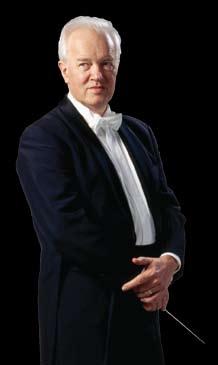
享譽國際的指揮大師艾度. 迪華特是香港管弦樂團的藝 術總監兼總指揮,有「樂團 建造者」的美譽,擅於將其 帶領的樂團提升至高度 卓越的藝術水平。他 曾任多個主要藝團的 總監職務,包括悉 尼交響樂團的藝術 總監兼總指揮、 荷蘭電台愛樂 樂團總指揮, 及鹿特丹愛樂 樂團、三藩市交 響樂團的音樂總 監等要職。最近,
迪華特亦獲美國著名的夏季歌劇節 —— 聖達菲 歌劇節委任為總指揮;由 2009/10 樂季起, 他將出任美國密爾沃基交響樂團音樂總監。
除指揮交響樂外,迪華特亦以指揮歌劇享譽國 際。他曾在世界頂尖歌劇院執棒,如高文花園 皇家歌劇院、德國拜萊特、紐約大都會,並曾
在三藩市和悉尼指揮全套華格納《指環》歌劇 音樂會,備受好評。他指揮香港管弦樂團演出 李察.史特勞斯的《莎樂美》、《深宮情仇》及 浦契尼的《蝴蝶夫人》歌劇音樂會,均獲高度 評價。
艾度.迪華特獲荷蘭政府頒發雄獅勳位,又獲 澳洲政府頒發澳洲勳章,以表揚他將悉尼交響 樂團提升至世界級地位,以及對澳洲與悉尼的 音樂和藝術生活所作出的貢獻。他獲香港演藝 學院頒發榮譽院士,讚揚他對音樂界 —— 尤其 是培育香港下一代音樂家 —— 的貢獻。
Edo de Waart is the Artistic Director and Chief Conductor of the Hong Kong Philharmonic Orchestra. Renowned as an ‘orchestral builder’ who has the enviable ability to transform his orchestras into world-class ensembles, Edo de Waart has held such distinguished positions as chief conductor and artistic director of the Sydney Symphony, chief conductor of the Netherlands Radio Philharmonic, as well as music director of the Rotterdam Philharmonic and San Francisco Symphony. Recently Edo de Waart was appointed Chief Conductor of one of the most prestigious summer opera festivals in the United States — the Santa Fe Opera. He will also take up the musical directorship of the Milwaukee symphony Orchestra for the 2009/10 season.
As an opera conductor Edo de Waart has enjoyed success in many of the great opera houses of the world including the Royal Opera House, Covent Garden, the Bayreuth and the Metropolitan Opera. He has led highly regarded performances of Wagner’s Ring Cycles in San Francisco and Sydney and has conducted a series of critically acclaimed concert performances of Salome, Elektra and Madama Butterfly with the Hong Kong Philharmonic.
Maestro de Waart has received a number of awards for his outstanding achievements in music. He is a Knight in the Order of the Dutch Lion and he was recently awarded the Order of Australia — a reflection of his invaluable contribution to Australian cultural life during his decade with the Sydney Symphony. He was appointed an Honorary Fellow of the Hong Kong Academy for Performing Arts in recognition of his contribution to music internationally and, in particular, his commitment to developing future generations of musicians in Hong Kong.
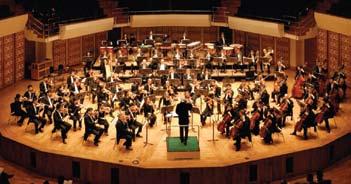
香港管弦樂團(港樂)是亞洲區內最具 領導地位的樂團之一,由享譽國際的指 揮大師艾度.迪華特出任藝術總監兼總 指揮。港樂豐富香港文化生命逾一世 紀,近 30 年來已發展成集華人與海外音 樂精英的傑出樂團,吸引世界級藝術家 同台獻藝。 2006 年 4 月,太古集團慈善 信託基金成為樂團的首席贊助,為期三 年慷慨贊助港幣三千六百萬元。香港管 弦樂團每年均透過一百五十多場演出, 觸動近 20 萬樂迷的心靈,包括一連串 外展活動,如吸引了近二萬名觀眾的大 型免費戶外音樂會「港樂.星夜.交響 曲」。
香港管弦樂團由香港特別行政區政府資助 香港管弦樂團首席贊助:太古集團
Hailed as one of Asia’s top orchestras, the Hong Kong Philharmonic Orchestra (HKPO) is one of the leading orchestras in the region, led by the internationally renowned Artistic Director and Chief Conductor Edo de Waart. Enriching Hong Kong’s cultural life for over a century, the last three decades has seen the Orchestra grow into a formidable ensemble of Chinese and international talents, attracting collaboration with many world-class artists. In April 2006 The Swire Group Charitable Trust became the Hong Kong Philharmonic’s Principal Patron, committing HK$36 million over three years to enable Maestro de Waart’s artistic vision for the Orchestra to be realised. The HKPO annually touches the lives of nearly 200,000 music lovers through more than 150 performances, including a series of outreach activities such as the free outdoor concert Symphony under the Stars which attracted nearly 20,000 people.
The Hong Kong Philharmonic Orchestra is financially supported by the Government of the Hong Kong Special Administrative Region.
SWIRE is the Principal Patron of the Hong Kong Philharmonic Orchestra.

泰妲安娜.夢諾嘉洛娃
泰妲安娜.夢諾嘉洛娃生於莫斯科,在俄羅斯藝術學院攻讀聲學。畢業後,她相 繼加盟夏利剛歌劇團及史坦尼斯拉夫斯基劇院任首席女高音。夢諾嘉洛娃在指揮 米高.尤洛夫斯基帶領下,隨莫斯科的論壇劇場,在德國演出歌劇《大師與瑪格 麗特》,首次踏足國外舞台。 1995 年,她在威尼斯鳳凰劇院上演的《沙皇鮑里 斯》中,飾演克賽尼亞。
2005/06 年樂季,她在米蘭史卡拉歌劇院首演,主唱《尤金.奧尼金》的泰妲安娜;而在美國的首 演,是隨俄羅斯國家管弦樂團,在紐約的艾弗里.費雪廳演唱柴可夫斯基《羅密歐與茱麗葉》和《哈 姆雷特》的配樂選段;隨後,加州的蒙特雷交響樂團為她舉行了一個群星音樂會。
2006/07 年的樂季,她有多項演出,包括為莫斯科大劇院自 1945 年來首次製作的《尤金.奧尼金》 飾演泰妲安娜;又在冰島首次演出,獻唱蕭斯達高維契的第十四交響曲。
Tatiana Monogarova was born in Moscow and studied voice at the Russian Academy of Arts. On graduation she joined the Helicon Opera and then the Stanislavsky Theatre as principal soprano. She made her first appearance abroad in The Master and Margarita with the Forum Theatre, Moscow under Michael Jurowski in Germany. In 1995 she sung Xenia in Boris Godunov at La Fenice in Venice.
For the 2005/06 season she made her debut at La Scala singing Tatiana in Eugene Onegin and also her US debut with the Russian National Orchestra singing scenes from Tchaikovsky’s incidental music for Romeo and Juliet and Hamlet in Avery Fisher Hall, New York. This was followed by a celebrity concert designed for her, with the Monterey Symphony Orchestra, California.
Amongst other engagements in the 2006/07 season she sang Tatiana in the new production of Eugene Onegin for the Bolshoi Theatre — the first since 1945, and made her debut in Iceland singing Shostakovich’s Symphony No 14.
Simon O’Neill
男高音 Tenor
奧尼爾生於新西蘭,是紐約大都會歌劇院、英國皇家高文花園歌劇院和薩爾茨堡 藝術節的首席演唱家。
這個樂季,奧尼爾在安東尼奧.帕帕奴的指揮下,在英國皇家高文花園歌劇院及 斯特拉斯堡的萊茵國家歌劇院,首度擔演《指環》的齊格蒙特;在紐約大都會歌 劇院,他與指揮唐納德.倫尼克斯合作《女武神》;2008年夏季,奧尼爾將參加

薩爾茨堡藝術節,在穆狄指揮的《奧賽羅》擔演主角;與丹尼爾.嘉提指揮的羅馬聖西西里學院管弦 樂團合作,飾演《帕西法爾》主角。
奧尼爾屢獲殊榮,繼有 2005 年新西蘭藝術桂冠獎、 2003 年紐約蘇利雲基金獎及英國華格納協會 獎、2002年入圍大都會歌劇院全國選拔賽決賽、1999年大都會歌劇院全國選拔賽鼓勵獎,以及1998 年傅爾布萊特獎學金;此外,奧尼爾是新西蘭歌劇院首位駐院青年藝術家。
A native of New Zealand Simon O’Neill is a Principal Artist with the Metropolitan Opera, the Royal Opera House, Covent Garden and the Salzburg Festival.
This season O’Neill makes his role debut as Siegmund in the new Ring Cycle at the Royal Opera House, Covent Garden with Antonio Pappano; at Opera du Rhin in Strasbourg with Donald Runnicles; and in 西蒙.奧尼爾
Die Walküre at the Metropolitan Opera. In the summer of 2008 he will sing the title role of Otello with Riccardo Muti at the Salzburg Festival and the title role of Parsifal in Rome at the Accademia di Santa Cecilia with Daniele Gatti.
A multi - award winning artist, O’Neill’s accolades include: Arts Laureate of New Zealand (2005); grand finalist in the 2002 Metropolitan Opera National Auditions; Sullivan Foundation Award of New York (2003); United Kingdom Wagner Society Prize (2003); Metropolitan Opera Audition Competition Encouragement Award (1999); and a Fulbright Scholarship (1998). He was also the inaugural Young Artist in Residence with Opera New Zealand.

男中音 Baritone
帕維.巴蘭斯基在烏克蘭國家音樂學院畢業,師從烏克蘭國家藝術家邁可 拉.干德拉迪奧克教授。
2000 年,巴蘭斯基於德國貝斯科奪得國際青年歌唱家比賽大獎,也在基輔
2003 年,他首次與漢堡國立歌劇院攜手演出《尤金. 奧尼金》,擔演主角,又與荷蘭 TROS 廣播公司管弦樂團合作,演出《黑桃皇后》的耶列斯基公 爵;2005年,他為威爾斯國立歌劇院演出《丑角》的西維歐。
2007/08 年樂季,除了在漢堡的工作,巴蘭斯基在西班牙華倫西亞的蘇菲亞女王藝術中心,重 演《情定修道院》,又與莫斯科室樂團攜手,在莫斯科演出一場大型匯演;在指揮大師歐貝里安 的棒下,巴蘭斯基會連同其他馬林斯基劇院的星級歌手,包括泰妲安娜.巴芙洛夫斯卡雅和丹 尼.施圖達合唱。
Pavel Baransky completed his studies at the National Academy of Music of Ukraine with the national artist of Ukraine Professor Mykola Kondratiuk.
In 2000 he won the International Competition of Young Singers Grand Prix in Beeskow, Germany and was a prize winner of the vocal competition in Kiev. In 2003 he made his debut with the Hamburgische Staatsoper, singing the title role in Eugene Onegin and with the TROS Orchestra, where he sang Yeletsky in Queen of Spades. In 2005 he performed Silvio in I Pagliacci for the Welsh National Opera.
During the 2007/08 season in addition to his work in Hamburg, he will reprise the Betrothal in a Monastery at the Palau de Les Artes in Valencia, Spain and will also appear in a major Gala concert in Moscow with the Moscow Chamber Orchestra. Conducted by Maestro Constantine Orbelian, Baransky will sing alongside the major Mariinsky Theatre stars: Tatiana Pavlovskaya and Daniil Shtoda.
《火鳥》組曲 (1919)
The Firebird Suite (1919)
史達拉汶斯基夥合戴亞基列夫的俄羅斯 芭蕾舞團,寫了三部至今仍是他作品中 最深入人心的舞曲,《火鳥》是三部之
首;儘管《火鳥》令他一舉成名,當初 他接受委約之時並非甘願,後來他寫 道,其實當時對這類題材沒有興趣, 「一如所有芭蕾舞劇,樂曲要求那種描 述性的音樂,是我不想寫的。」他認為 這個樂種保守過時,而且他的老師林姆 斯基-高沙可夫是箇中高手,他也擔心有 珠玉在前會被比下去。
畢竟,能讓自己的作品走出俄國的機 會始終不容放過, 1909 年 11 月,史達 拉汶斯基寄居在林姆斯基 - 高沙可夫的 一間鄉間小屋,開始寫作《火鳥》,翌 年初於聖彼得堡完成,並遠赴巴黎協助 演出的準備工作。在 1910 年 6 月首演 當晚,史達拉汶斯基初次接觸到一些 當時的名人:如普魯斯特、莎拉.本恩 哈特、德布西等,還有很多藝術界和社 交要人;這是他事業上的首個突破,亦 使委約陸續而來 第二部的《彼得羅 什卡》( 1911 )和第三部的《春之祭》 ( 1913 ),迅速令史達拉汶斯基在音樂 史上穩佔一席。
多年後,史達拉汶斯基這樣形容《火 鳥》:「為了配合當時的時尚,《火鳥》 比當時一般民族風格的創作更精進用
心,但同時沒有太多新意,這都是有助 成功的因素。」如此帶點輕視的評語,
With The Firebird , Igor Stravinsky received a commission that would lift him out of obscurity. It would be the first of three great collaborative works with Diaghilev’s Ballet Russes — the three works for which he is still best known — and yet he accepted it reluctantly. He later wrote that the subject had not interested him at the time saying: “Like all story ballets it demanded descriptive music of a kind I did not want to write.” Stravinsky considered it old - fashioned. He also feared being compared unfavourably with his teacher Nikolai Rimsky - Korsakov, a master of this type of music.
But, with the prospect of having his music heard outside of Russia, Stravinsky began work on The Firebird at a dacha (country house) belonging to Nikolai RimskyKorsakov in November 1909. He completed the score in St Petersburg in the early months of 1910 and travelled to Paris to assist in its preparation. At the premiere in June 1910 Stravinsky had his first encounter with celebrity — meeting Marcel Proust, Sarah Bernhardt, Claude Debussy and many other leading figures of the artistic world and society. He also experienced his first major success. This achievement led to a second commission Petrushka (1911), and a third, The Rite of Spring (1913), rapidly sealing his place in music history.
Many years later Stravinsky described The Firebird as belonging “to the styles of its time. It is more vigorous than most of the composed folk music of the period, but it is also not very original. These are all good conditions for a success.” His dismissive comments belie The Firebird’s significance in his development
掩蓋了樂曲在他的音樂創作發展過程之 重要;《火鳥》給聽眾留下深刻印象,
奠定他日後開拓指揮事業的基礎,他把 握芭蕾舞曲的成功,在1911年寫成第一 首《火鳥》組曲,第一次世界大戰結束 後不久,於1919年再完成第二首,兩首 作品成為他往後經常指揮的曲目。
脫離原作的舞台背景,這首組曲換上一
身豐富的器樂效果,受歡迎程度絕不遜 於原版。引子幽幽地開始:低音弦部奏 出重複的六音音形,就像向看不見的獵 物潛行,一對伸縮號奏出隱約的旋律, 木管與低音弦部交替,整個弦樂組突然 奏出諧音上滑奏,然後長笛和雙簧管獨 奏接上六音音形。火鳥的進場帶出第一 個宏大的聲響,由管弦二部合奏;稍 稍停頓後,一支翩翩飛舞的單簧管和鳥 語一樣的長笛標誌着活潑的〈火鳥變奏 曲〉的開始,這一段充滿不跟拍子的重 音。溫柔的〈公主之舞〉開始時,長笛 奏出主旋律的片段,號角伴奏,然後
旋律由雙簧管、單簧管和巴松管承奏。
〈魔王卡差之舞〉用很強的和弦開始, 樂章中可以找到一些史氏最細緻的器樂 效果,包括一個伸縮號的滑奏。
一陣狂怒之後,舞蹈靜靜結束,〈搖籃 曲〉滲入,由巴松管迂迴的旋律開始。
在終曲,史達拉汶斯基引入不規則的拍 子,日後成為了他音樂上一大特色,但 這一段最引人注意的是主旋律,由一支 號角獨奏,配合閃爍的弦樂,逐漸奏起 宣告勝利的歡呼。
as a composer. The strong impression it made on listeners enabled him to pursue a conducting career. He seized on the success of the ballet to complete the first Firebird concert suite in 1911 and a second one in 1919, soon after World War I, conducting them frequently.
Separated from its original context as a stage work, the suite lost none of its popularity owing largely to its many orchestral effects. The introduction begins quietly: the lower strings playing a repeating six - note figure, prowling towards some unseen prey; a pair of trombones arrive with a hint of melody; woodwinds enter, alternating with the lower strings; the full string section interrupts with a glissando on the harmonics, before a solo flute and oboe pick up the six - note figure. The entry of the firebird provides the first loud sounds, with strings and winds together. After a pause, a fluttering clarinet and chirping flutes signal the start of the lively Variation of the Firebird, a section filled with off - beat accents. The gentle Princesses’ Round begins with the flutes playing a fragment of the main melody accompanied by the horns, and then passing the melody to the oboe, clarinet and bassoon. Beginning with a fortissimo chord, The Infernal Dance of King Kastchei contains some of Stravinsky’s finest orchestral effects, among them a trombone glissando
After all its fury the dance closes quietly, blending into the Lullaby with its sinuous melody introduced by the bassoon. In the finale Stravinsky introduces the irregular meters that would become a defining element of his music, but it is the main melody that dominates the section, introduced by a solo horn over shimmering strings before growing increasingly triumphant.
Igor Stravinsky
替俄羅斯芭蕾舞團寫下了經典的作品、
經歷過第一次世界大戰的動蕩,史達拉 汶斯基找到新的音樂風格,在往後 30 年 加以培養。1920年開始,史達拉汶斯基 探索巴羅克及古典時期的音樂形式。
《詩篇交響曲》是為紀念波士頓交響樂
團成立 50 周年而作, 1930 年12 月 19 日 由該團演出;對於作品的標題,他說: 「這不是一首以詩篇為歌詞的交響曲, 相反,我以交響樂表達詩篇的詠唱。」
三首詩篇取自拉丁文聖經《武加大譯 本》,為了不讓聽眾有任何浪漫聯想, 他把器樂中幾種表現力強的樂器收起, 包括單簧管、小提琴和中提琴。
第一部份填上詩篇第 38 章第 13 、 14
節,在《彼得羅什卡》和《春之祭》塑 造出現代感的八音音階再次發揮作用, 拉開序幕的雙簧管和巴松管,奏着八 音音階的樂段,用重複的 E 小調和弦點 綴,成為調性中心;詠唱開始時只有兩 個音高,讓人想起格雷果聖咏。第二部 份以賦格的風格填上詩篇第 39 章第二 至四節,由雙簧管和笛子起奏。樂曲末 段用了詩篇第 150 章充滿喜悅的字句, 但開始時是沉思的調子,各聲部一起進 入,在對位詠唱,器樂奏出爬升的旋律 音形加以襯托,巴松管和圓號奏出重複 的音形,帶出對比,交響曲便在寂靜中 完結。
— 中場休息 —
After his landmark works for the Ballet Russes and the upheaval of World War I, Stravinsky settled into a new musical style that he would cultivate for some 30 years. He began in 1920 to explore musical forms from the Baroque and Classical eras.
Stravinsky composed the Symphony of Psalms for the 50th anniversary of the Boston Symphony Orchestra, which performed it on the 19 December 1930. Concerning the title he said: “it is not a symphony in which I have included Psalms to be sung. On the contrary, it is the singing of the Psalms that I am symphonising.” The three Psalms are taken from the Vulgate Bible and are sung in Latin. Seeking a sound free of romantic associations, Stravinsky excluded the more expressive instruments — clarinets, violins, violas — from the orchestra.
The first part, a setting of verses 13 and 14 of Psalm 38, opens with oboe and bassoon playing a passage that makes use of the octotonic scale — an eight - note scale that had helped to shape the modern sound of Petrushka and The Rite of Spring — punctuated by E minor chords that provide the tonal centre through repetition. When the voices enter, they sing on only two pitches, suggesting Gregorian chant. The second part, a fugual setting of verses two, three and four from Psalm 39, opens with oboes and flutes. Stravinsky closes the symphony with the joyous words of Psalm 150, but opens this movement with meditative music. Voices enter together and then sing in counterpoint accompanied by rising melodic figures in the orchestra. After a contrasting section driven by repeated figures in the bassoons and horns, the symphony ends in quiet calm.
《鐘》
The Bells
1912 年的春天,拉赫曼尼諾夫收到一封 信,內附一首詩,是美國作家埃德加.愛 倫.坡 ( 1809–1849 ) 所寫的《鐘》,
來信人促請拉赫曼尼諾夫替此詩譜上音 樂;當時拉赫曼尼諾夫只寫過一首合唱 作品,即 1902 年的清唱劇《春天》。受
此信的啟發,1912年底,他到了羅馬, 搬進在西班牙廣場的房子,這也是柴可 夫斯基曾下塌的地方;他在那裏開始 《鐘》的寫作,完成了大部份之後,翌 年夏季在家鄉完成整首樂曲,同年 11 月 30 日在聖彼得堡的貴族演奏廳(即現在 的愛樂大廳)首演。此後,拉赫曼尼諾 覺得《鐘》可算是他身為作曲家的最高 成就。
拉赫曼尼諾夫用以譜曲的文字並非愛 倫.坡的英文原文,而是由俄國象徵 主義詩人巴爾曼( 1867–1941 )翻譯 的俄文版本,他刪去很多原詩的節奏 (「和着拍子、拍子、拍子」),但保留 了黑暗的意象;當中歡樂和恐懼、生 和死等對立的主題,勾起了作曲家的興 趣,貫通全文的鐘聲,引發他強烈的共 鳴,他說:「在我認識的俄國城市裏, 由諾夫哥洛德、基輔到莫斯科,教堂鐘 聲隨處可聞,每一個俄羅斯人從長大到 死亡,都有鐘聲陪伴。」
要把這四部份的詩譜成樂曲需要大型的 曲式:一首四樂章的合唱交響曲。在開 始的〈快板〉(「聽那雪橇的響鈴」),
In the spring of 1912 Sergey Rachmaninov received by post a copy of the poem The Bells by the American writer Edgar Allan Poe (1809-1849). Accompanying the text was a letter from an anonymous writer, urging him to set the words to music. Rachmaninov had, up to this time, composed just one work for chorus and orchestra, the 1902 cantata Vesna (‘Spring’). And yet, like his correspondent, he felt inspired. Late in 1912 he travelled to Rome took an apartment on the Piazza de Spagna where Tchaikovsky had once lived, and got to work. He composed much of The Bells there and completed it the following summer at his Russian estate. He conducted the first performance in St Petersburg’s Hall of the Nobility (now known as the Great Philharmonic Hall) on the 30 November 1913. Thereafter he came to consider The Bells his finest achievement as a composer.
The text that Rachmaninov used had been freely adapted by the Russian symbolist poet Konstantin Balmont (1867–1942), who left little of Poe’s rhythmic poetry (“Keeping time, time, time”), but retained the dark imagery. Its contrasting themes of joy and horror, birth and death appealed to the composer. Its use of bells as a unifying element resonated strongly with him: “The sound of church bells dominated all the cities of the Russia I used to know — Novgorod, Kiev, Moscow. They accompanied every Russian from childhood to the grave.”
The poems also suggested a large - scale musical form: a four - movement choral symphony. In the opening allegro (“Hear, hear the sleighs fly past”), an exuberant orchestral introduction prepares the way for the arrival of the tenor soloist. But to this paean to
豐富的器樂引子為男高音獨唱的進場鋪 路,在愛倫.坡這首為喜樂、生命和青 春喝彩的讚美歌上,巴爾曼用文字加添 了一個含蓄的預兆,拉赫曼尼諾夫把這 點信手拈來,製造了一個反差的中段, 當合唱唱着「聽那雪橇的鈴聲,那叮噹 的銀鈴」的時候,男高音在圓號的伴奏 下,唱出:「可是鈴聲已宣告了許諾, 虛幻也不能拖延的許諾,芸芸眾生,等 待的是永遠沉睡不起,最終極的深鬱甜 美。」合唱團吟唱着九音樂句,一面再 相繼加入:女中音、男高音、女高音、 最後是低音,完結了中段,樂曲氣氛快 速回復,上升到紛亂的高潮。
「死亡」既是巴爾曼版本經常出現的元 素,拉赫曼尼諾夫也多處引用了《末日 經》的素歌旋律。即使在第二樂章,中 提琴奏出的旋律亦隱指《末日經》;合
唱進入,帶領我們去「聽那圓潤的婚禮 鐘聲」,女高音獨唱出一些拉赫曼尼諾 夫作品中最抒情的樂段。第三樂章沒有 獨唱,偶爾卻能聽到喧鬧中有一把獨唱 聲音。
終樂章與柴可夫斯基的《第六交響曲》
異曲同工,開始時,一支英國號引出一 個被壓抑着、使人不能釋懷的旋律,被 器樂兩度打斷之後,男低音獨唱出「聽 那索命的鐘聲」。在最後的幾句,他唱 到絕境之處,音樂卻仍是叫人安心的, 器樂獨自重奏巴爾曼在第一樂章中的那 句:「等待的是永遠沉睡不起,最終極 的深鬱甜美」。
樂曲介紹:拜恩.湯臣
the joys of birth and youth, Balmont added a gentle omen that provided Rachmaninov with a ready - made contrasting middle section. In his adaption, as the chorus chimes, “Hear the sledges with the bells, hear the silver - throated bells”, the tenor, accompanied by a solo horn sings, “a promise they do declare, that beyond illusion’s cumber, births and lives beyond all number, waits a universal slumber, deep and sweet past all compare.”
Humming a nine - note phrase, the chorus re - enters in succession: altos, tenors, sopranos and finally the basses, all bringing the middle section to a close. Quickly recovering the opening mood, the music rises to a tumultuous climax.
With death a persistent element in Balmont’s adaptation, Rachmaninov quotes in several instances, the plainchant melody of the Dies Irae, or Day of Judgment. Even in the second movement he suggests it in the melody, introduced by the violas. After the chorus enters impelling us to “Hear the mellow wedding bells”, the solo soprano sings some of the most lyrical passages Rachmaninov ever composed. No soloist appears in the third movement but there are few moments when a solo voice can be heard above the din.
Comparisons between the closing movement and Tchaikovsky’s Symphony No 6 are inevitable. A solo English horn introduces the movement with a subdued and haunting melody. Twice the orchestra interrupts before the bass soloist enters with the line “hear the tolling of the bell”. With his final words he sings of doom and yet the music is reassuring, recalling through the orchestra alone Balmont’s additional line from the opening movement: “a universal slumber, deep and sweet past all compare.”
Programme notes by Brian C Thompson
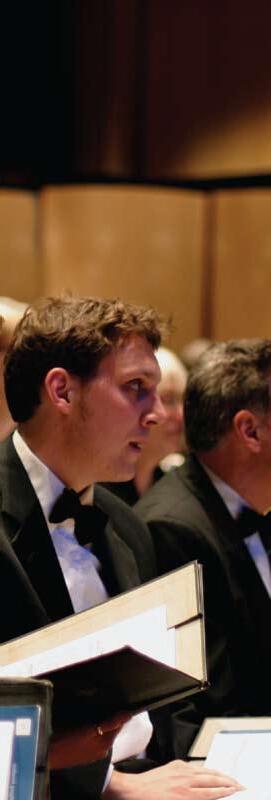
Symphony of Psalms
Exaudi orationem meam, Domine, et deprecationem meam.
Auribus percipe lacrimas meas. Ne sileas, ne sileas.
Quoniam advena ego sum apud te et peregrinus, sicut omnes patres mei.
Remitte mihi, prius quam abeam et amplius non ero.
Expectans expectavi Dominum, et intendit mihi. Et exaudivit preces meas; et exudit me da lacu miseriae, et de lato faecis.
Et statuit super petram pedes meos: et direxis gressus meos.
Et immisit in os meum canticum novrum, carmen Deo nostro.
Videbunt multi, videbunt et timabunt: et aperabunt in Domino.
Alleluia.
Laudate Dominum in sanctis Ejus.
Laudate Erum firmamentis virtutis Ejus.
Laudate Dominum. Laudate Eum in virtutibus Ejus
Laudate Eum secundum multitudinem magnitudinis Ejus.
Laudate Eum in sono tubae.
Laudate Eum. Alleluia. Laudate Dominum.
Laudate Eum. Laudate Eum in timpano et choro, Laudate Eum in cordis et organo;
Laudate Eum in cymbalis bene jubilantionibus.
Laudate Eum, omnis spiritus laudate Dominum. Alleluia. –
Interval –
《詩篇交響曲》
主啊,求祢聽我的禱告, 留心聽我的呼求,
請祢不要對我的眼淚無動於衷; 因為在祢面前,我是個過客、是寄居的人, 像我的列祖一樣; 啊,求祢寬容,讓我在一去不返之前, 恢復我的力量 。
我耐心等候主,祂垂聽我的呼求。
祂把我從可怕的深淵、 從泥濘淤土中拉出來, 使我能穩站磐石上, 能邁步前往。
祂更教我唱一首新歌, 來讚美我們的神; 許多人會看見它、敬畏它, 並把信心靠向主 。
哈利路亞。
讓我們在主的聖殿讚美祂: 在祂顯力量的穹蒼讚美祂;
在祂的德行中讚美祂: 因祂無比的偉大讚美祂;
用號角聲讚美祂:
用琴瑟讚美祂;
用絲竹讚美祂;
用調和的鈸讚美祂;
凡有氣息的都讚美祂; 哈利路亞。
Symphony of Psalms
Hear my prayer, O Lord, and with Thine ears consider my calling: hold not Thy peace at my tears. For I am a stranger with Thee: and a sojourner, as all my fathers were.
O spare me a little that I may recover my strength: before I go hence and be no more.
I waited patiently for the Lord: and He inclined unto me, and heard my calling. He brought me also out of the horrible pit, out of the mire and clay. and set my feet upon the rock, and ordered my goings. And He hath put a new song in my mouth: even a thanksgiving unto our God. Many shall see it and fear: and shall put their trust in the Lord.
Hallelujah.
O praise God in His holiness: Praise Him in the firmament of His power.
Praise Him in His noble acts: Praise Him according to His excellent greatness. Praise Him in the sound of the trumpet: Praise Him upon the lute and harp. Praise Him upon the strings and pipe. Praise Him upon the well - tuned cymbals. Let everything that hath breath praise the Lord. Hallelujah.
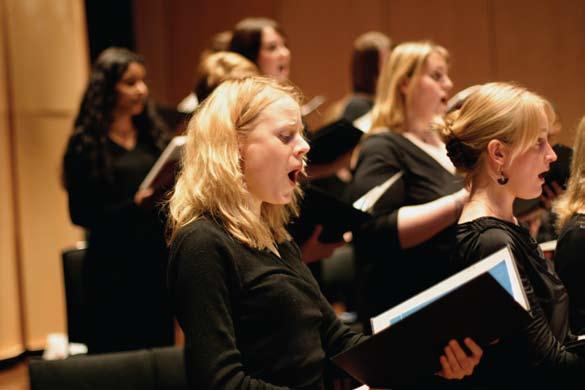
《鐘》(俄文演唱) 聽那雪橇的響鈴 那銀鐘!
悅耳的鐘聲預示了一個多歡欣的世界! 在寒夜冰涼的空氣中,
聽它們玎玲、玎玲、玎玲! 灑滿穹蒼的繁星,
帶着晶瑩剔透的喜悅, 在閃動,
和着拍子、拍子、拍子, 像遠古北國的節奏;
銀鐘溢出悠揚的鈴響, 來自那銀鐘、銀鐘、銀鐘、銀鐘, 鐘、鐘、鐘 這玎玲錚瑽的銀鐘。
聽那圓潤的婚禮鐘聲 ── 那金鐘!
諧和的鐘聲預示了一個多幸福的世界! 劃破芬芳的夜空, 奏出那喜樂融融! 從那金鑄的音符,
入調諧和的音符,
一支多麼流麗的小曲, 飄向那在傾聽的有情人,
The Bells (Performed in Russian) Hear the sledges with the bells — Silver bells!
What a world of merriment their melody foretells! How they tinkle, tinkle, tinkle, In the icy air of night! While the stars that over sprinkle All the heavens, seem to twinkle With a crystalline delight; Keeping time, time, time, In a sort of Runic rhyme, To the tintinnabulation that so musically wells
From the bells, bells, bells, bells, Bells, bells, bells — From the jingling and the tinkling of the bells.
Hear the mellow wedding bells — Golden bells!
What a world of happiness their harmony foretells! Through the balmy air of night How they ring out their delight! From the molten - golden notes, And all in tune, What a liquid ditty floats
To the turtle - dove that listens, while she gloats
一個沾沾自喜地望着月亮的有情人! 哦,從那些鐘樓,
源源湧出如斯美妙動聽的鐘聲!
鐘聲那樣滿溢豐盈,
鐘聲那樣憧憬着未來, 那樣訴說一份酣樂,
鼓動了鐘的蕩漾響動,
來自這金鐘、金鐘、金鐘, 這金鐘、金鐘、金鐘、金鐘, 鐘、鐘、鐘
這抑揚如歌的金鐘。
聽那雷動的警鐘 ──
聽那銅鐘!
喧嚷的鐘聲在講述一個多恐怖的故事! 在黑夜倉惶的耳裏,
它們把驚愕都化成嚎叫, 懼怕得不成聲調,
只能吱吱低嘯, 走了板的低嘯,
在噪聒地要求火焰網開一面, 在對置若罔聞的瘋火癡癡勸戒,
火越竄越高,越竄越高,越竄越高, 以孤注一擲的意志,
以果敢不屈的努力,
要坐在臉色蒼白的月亮旁邊,
現在 ── 要麼現在就坐,要麼永不; 哦,那警鐘、警鐘、警鐘! 它的慌亂在傳達一個 多麼絕望的故事!
聽它們怎樣鏗鏘、撞擊、咆哮, 傾瀉出如斯的驚恐,
流進悸動的空氣的懷抱! 但那耳朵卻很清楚,
憑那彈撥,
還有那鏗鏘,
那危險是怎樣如潮漲落;
但那耳朵一聽即明,
憑那亂響,
還有那爭吵,
那危險是怎樣起起伏伏,
就在鐘聲悲憤的起起伏伏間,
來自那銅鐘
那銅鐘、銅鐘、銅鐘、銅鐘,
鐘、鐘、鐘
那怒吼叫喊的銅鐘。
On the moon!
Oh, from out the sounding cells, What a gush of euphony voluminously wells! How it swells!
How it dwells
On the Future! how it tells Of the rapture that impels To the swinging and the ringing Of the bells, bells, bells, Of the bells, bells, bells, bells, Bells, bells, bells — To the rhyming and the chiming of the bells!
Hear the loud alarum bells — Brazen bells!
What a tale of terror, now, their turbulency tells! In the startled ear of night How they scream out their affright! Too much horrified to speak, They can only shriek, shriek, Out of tune,
In a clamorous appealing to the mercy of the fire, In a mad expostulation with the deaf and frantic fire, Leaping higher, higher, higher, With a desperate desire, And a resolute endeavour, Now — now to sit or never, By the side of the pale - faced moon. Oh, the bells, bells, bells!
What a tale their terror tells Of Despair!
How they clang, and clash, and roar! What a horror they outpour On the bosom of the palpitating air!
Yet the ear it fully knows, By the twanging, And the clanging, How the danger ebbs and flows: Yet the ear distinctly tells, In the jangling, And the wrangling, How the danger sinks and swells, By the sinking or the swelling in the anger of the bells — Of the bells —
Of the bells, bells, bells, bells, Bells, bells, bells — In the clamour and the clangour of the bells!
聽那索命的鐘聲
聽那鐵鐘!
那輓歌刻出一個多儼然的世界!
在萬賴俱寂的夜裏,
當聽到憂鬱的鐘聲那威嚇的語調,
我們在恐懼中顫抖!
因為那鐘聲,
來自發鏽的咽喉,
是聲聲的呻吟。
而那些人 啊,那些人,
他們住在尖塔上,
是孤獨的,
他們把喪鐘敲響,敲響、敲響, 在鬱悶而千篇一律的鐘聲裏,
感受到一種光榮,
像一塊石頭在心頭滾動, 他們非男非女,
他們非人非獸,
他們是幽靈:
正是他們的君王把喪鐘敲響, 他敲着、敲着、敲着, 他從鐘裏
奏出一曲讚歌, 他快活的胸膛
隨着喪鐘的讚歌起伏, 他起舞、他叫嚷,
和着拍子、拍子、拍子, 就像遠古北國的節奏, 合着來自喪鐘的 一曲讚歌:
和着拍子、拍子、拍子, 就像遠古北國的節奏; 合着跳動的鐘聲, 鐘聲、鐘聲、鐘聲 合着抽噎的鐘聲; 和着拍子、拍子、拍子, 當他敲着喪鐘, 敲着、敲着, 以快活的北國節奏, 合着鐘聲的滾動 來自那鐵鐘、鐵鐘、鐵鐘, 合着索命的鐘聲, 來自那鐵鐘、鐵鐘、鐵鐘、鐵鐘, 鐘、鐘、鐘 那悲鳴吁嘆的鐵鐘。
Hear the tolling of the bells — Iron Bells!
What a world of solemn thought their monody compels! In the silence of the night, How we shiver with affright At the melancholy menace of their tone! For every sound that floats From the rust within their throats Is a groan.
And the people — ah, the people — They that dwell up in the steeple, All Alone
And who, tolling, tolling, tolling, In that muffled monotone, Feel a glory in so rolling On the human heart a stone — They are neither man nor woman — They are neither brute nor human — They are Ghouls:
And their king it is who tolls; And he rolls, rolls, rolls, Rolls
A paean from the bells!
And his merry bosom swells With the paean of the bells! And he dances, and he yells; Keeping time, time, time, In a sort of Runic rhyme, To the paean of the bells — Of the bells:
Keeping time, time, time, In a sort of Runic rhyme, To the throbbing of the bells — Of the bells, bells, bells — To the sobbing of the bells; Keeping time, time, time, As he knells, knells, knells, In a happy Runic rhyme, To the rolling of the bells — Of the bells, bells, bells: To the tolling of the bells, Of the bells, bells, bells, bells — Bells, bells, bells —
To the moaning and the groaning of the bells.
埃德加.愛倫.坡詩作原文
Original poem by Edgar Allan Poe
2008年2月24日(星期日)
韓德爾 (1685–1759)
浦塞爾 (1658–1695)
塔弗納 (1944– )
《祭司長撒督》
《讓你的手剛強》
《聽我的禱告》
《雅典妮之歌》
《虎》(取自威廉.布萊克同名詩)
朱利安.安德遜 (1967– ) 《我是朝聖者》
– 中場休息 –
帕里 (1848–1918)
《我喜悅》
拉爾夫.沃恩.威廉斯 《音樂小夜曲》 (1872–1958)
狄伯特 (1905–1998)
《五首黑人靈歌》,選自《我們世代的孩子》
悄然離去(合唱和獨唱)
無人知曉(合唱和獨唱)
去吧,摩西(合唱和獨唱低音)
快了(合場和獨唱女高音)
深河(合唱和獨唱)
拉爾夫.沃恩.威廉斯 《讓世界每個角落都放聲歌唱》,選自《五首神秘之歌》
演出者
鋼琴/管風琴 伊安.法林頓 指揮 尼威爾.克里特
倫敦愛樂合唱團
24 February 2008 (Sunday) Programme
George Frideric Handel
Zadok the Priest (1685–1759)
Let thy hand be strengthened
Henry Purcell (1658–1695) Hear My Prayer
John Tavener (1944– )
Song for Athene
The Tyger (from the poem by William Blake)
Julian Anderson (1967– ) I’m a Pilgrim – Interval –
Hubert Parry (1848–1918) I was Glad
Ralph Vaughan Williams Serenade to Music (1872–1958)
Michael Tippett (1905–1998)
Five Negro Spirituals from A Child of Our Time
Steal Away (chorus and solo)
Nobody Knows (chorus and solo)
Go Down, Moses (chorus and bass solo)
O, By and By (chorus and soprano solo)
Deep River (chorus and solo)
Ralph Vaughan Williams Let all the world in every corner sing from Five Mystical Songs
Performers
Piano and Organ Iain Farrington Conductor Neville Creed
London Philharmonic Choir
尼威爾.克里特 指揮
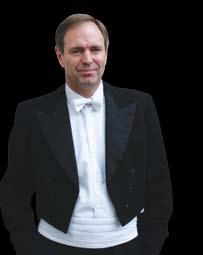
1994 年,克里特獲委任為倫
敦愛樂合唱團的指揮,並在 2002年成為藝術總監;在合唱 團慶祝成立 50 周年的音 樂會。他首次指揮合 唱團,在皇家阿爾拔 演奏廳演出沃恩. 威廉斯的《海洋交 響曲》,之後在英 國及海外多個音樂 會指揮合唱團的 演出。
克里特於劍橋大學 聖三一學院研究合唱作 品時,就開展了指揮 的事業;當他在英國倫敦市政廳音樂戲劇學 院研究指揮,已贏得利哥迪指揮大獎。學成
後,克里特先後被委任為伯恩茅斯交響合唱 團及吉爾福德愛樂合唱團領隊的合唱總監, 並成立了自己的室樂合唱團,取名「牛津合唱 團」;2003年,克里特離開了伯恩茅斯交響合 唱團,接任牛津聖愛德華學校的音樂總監。
在克里特的領導下,伯恩茅斯交響合唱團贏得 兩個重要獎項,包括與指揮烈頓合作,贏得格 林美獎的沃爾頓作品《伯沙撒的盛宴》之錄 音。此外,克里特曾帶領伯恩茅斯交響合唱 團,於皇家節日音樂廳首演布萊克福德《放逐 之聲》,並於電視轉播。
克里特的國外演出包括在法國指揮歐洲共同體 室樂團,在奧地利布雷根茨藝術節演出,在德 國演出布列頓的《戰爭安魂曲》;在英國演出 方面,克里特曾與多個主要樂團、合唱團和合
奏組合同台演出。
Neville Creed has held the position of Chorus Director of the London Philharmonic Choir (LPC) since 1994 and in 2002 was appointed Artistic Director. He made his conducting debut at the Royal Albert Hall, London, with Vaughan Williams’s Sea Symphony for the Choir’s 50th birthday concert and has subsequently conducted the LPC in many concerts both at home and abroad.
He began his conducting career whilst a choral scholar at Trinity College, Cambridge. At the Guildhall School of Music he was a conducting scholar and won the Ricordi Conducting Prize. After his studies he was appointed chorus director of the Bournemouth Symphony Chorus and the Guildford Philharmonic Choir and founded his own chamber choir — The Oxford Singers. In 2003 he relinquished his position in Bournemouth in order to take up the post of Director of Music at St Edward’s School, Oxford.
The Bournemouth Symphony Chorus won two major awards under Creed’s direction including a Grammy Award for their recording of Walton’s Belshazzar’s Feast with Andrew Litton. Creed conducted the first performance of Richard Blackford’s Voices of Exile at the Royal Festival Hall with the Bournemouth Symphony Chorus, and made a recording of the work for television.
Creed‘s work abroad includes conducting the European Community Chamber Orchestra in France, the Bregenz Festival in Austria, and Britten’s War Requiem in Germany. He has given concerts with major British orchestras, choirs and ensembles.
伊安.法林頓 鋼琴/管風琴
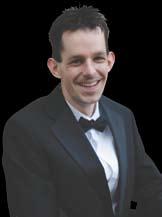
伊安.法林頓是一位多 才多藝的音樂家,他彈 奏管風琴和鋼琴,亦能 編曲和作曲。他於皇家 音樂學院及劍橋聖約翰 學院修讀管風琴, 曾在溫莎堡聖佐治 禮拜堂擔當管風 琴學人,於無 數皇室聚會中 演奏。他在英 國各地舉行管 風琴獨奏會,包括曼徹斯特的布里奇沃特音樂 廳,足跡也遍及歐洲、日本、南非和馬來西 亞等地,又曾於 2007 年的逍遙音樂會獻技。 法林頓推出過多張唱片,他的演奏及錄音獲英 國廣播公司的電視、電台第三台及電台「古典 FM」播放。
在鋼琴演奏方面,法林頓曾於英國多個重要場 地演出,包括威格摩爾音樂廳和依麗莎伯女皇 演奏廳;又曾與多位頂尖英國音樂家合作,計 有萊絲莉.葛瑞特、英國廣播電台合唱團、西 蒙.歷圖爵士和哥連.戴維斯爵士;他和他的 室樂組合「法林頓室樂團」更是演出無數,同 時也為倫敦愛樂合唱團伴奏。
法林頓編曲的作品過百,包括艾爾加 / 佩尼的 第三交響曲鋼琴獨奏版,以及艾爾加的五首鋼 琴即興曲;他的器樂及詠唱創作大獲好評,管 風琴組曲《節慶》已錄成專輯,並常於世界各 地演出,成績非凡。
Iain Farrington is an exceptional organist, pianist, arranger and composer. He studied organ at the Royal Academy of Music and at St John’s College Cambridge University, and was Organ Scholar at St George’s Chapel, Windsor Castle, playing for numerous royal occasions. He has given organ recitals across the UK (including Bridgewater Hall, Manchester) and has performed across Europe, in Japan, South Africa, Malaysia, and in the Proms 2007. He has made numerous recordings and has broadcast on BBC Television, BBC Radio Three and Classic FM.
As a pianist, Farrington has performed at many major UK venues including the Wigmore Hall and the Queen Elizabeth Hall, and he has worked with some of the UK’s leading musicians including Lesley Garrett, the BBC Singers, Sir Simon Rattle and Sir Colin Davis. He performs extensively with his chamber group the Farrington Ensemble, and is the accompanist for the London Philharmonic Choir.
Farrington has arranged more than one hundred works including a solo piano arrangement of Elgar/Payne Symphony No 3, and a transcription of Elgar’s Five Piano Improvisations. His instrumental and choral compositions have received critical acclaim, and his organ suite Fiesta! has achieved great success both as a recording and through frequent performances around the world.
《祭司長撒督》
Zadok the Priest
《讓你的手剛強》
Let thy hand be strengthened
這兩首樂曲是韓德爾為1727年英皇佐治 二世的加冕大典而寫的。即使有說,韓 德爾因為與佐治二世都是來自德國漢諾 威而得到眷顧,但作品的實力令謠言不
攻自破。在加冕典禮中,作品的演奏毫 不突出,但韓德爾深知作品的價值,不 欲等待下一個加冕大典的演奏機會,於 是在1730年代把這兩首讚美歌加入他的 神劇作品,並在1743年出版。
韓德爾親自從聖經中挑選歌詞:《祭司 長撒督》取自列王紀上,敘述所羅門王 受塗油禮;《讓你的手剛強》取自詩篇 第 89 章。《祭司長撒督》的前奏曲中, 上升的琶音讓合唱部份華麗地進場,歡 騰由此伸延到曲終。《讓你的手剛強》 的織體和感情較為多變,在歡騰部份之 後,中段提出一個內省的對比,然後樂 曲在「哈利路亞」中完結。
Handel composed Zadok the Priest and Let thy hand be strengthened on commission for the 1727 coronation of George II. If the fact that both he and King George were from Hanover in Germany caused some to suggest preferential treatment, the results dispelled such gossip. Despite a weak performance at the coronation, Handel recognised the value of what he had composed. Not wishing to wait until the next coronation to hear his music performed again, he incorporated the anthems into oratorios in the early 1730s and published them in 1743.
Handel selected the Biblical texts himself: taking the Zadok from 1 Kings , describing the anointing of Solomon, and adapted Let thy Hand from Psalm 89. The rising arpeggios of the Zadok prelude prepare for one of the most majestic entries in the choral repertoire. From that point the exultation continues straight through to the end. Let thy hand be strengthened offers a greater range of textures and moods. After ‘exultation,’ the middle section provides a reflective contrast before the ‘Alleluia.’
《聽我的禱告》
Hear My Prayer
生為一位宮廷音樂家之子,浦塞爾短促
的生命與他在西敏寺聽到的音樂緊緊相 連;他在皇家禮拜堂參加聖詩班, 16 歲
就替西敏寺大教堂的管風琴調音, 18 歲
成為皇家小提琴作曲家, 30 未到,他已 被公認為當時英國數一數二的作曲家。
對於浦塞爾我們所知不多,他是個怎樣 的人只能從他的音樂去推敲,一般認為 《聽我的禱告》是他二十多歲時寫的, 作品經精心雕琢,細緻地平衡熾烈情感 和自我約束,此曲亦可能是一個已失傳 的大型作品的片段。
John Tavener
《雅典妮之歌》
Song for Athene
《虎》
The Tyger
約翰.塔弗納自 1960 年代末為人注意 之始,即創作大量聲樂作品,《雅典妮 之歌》作於1 993 年,為紀念一位年青 的演員,亦是他好友的女兒雅典妮.海 莉阿德思而寫;歌詞取自莎士比亞的 《哈雷姆特》, 1997 年在戴安娜皇妃的 喪禮上亦有演奏。至於《虎》,是塔弗 納為1995年逝世的作家菲力普.謝拉特 所寫,歌詞來自威廉.布萊克的詩作; 兩首作品都是無伴奏合唱。
As the son of a court musician, Henry Purcell lived his short life closely connected to the music heard at Westminster. He served as a boy chorister at Chapel Royal, became the tuner of the Westminster Abbey organ at 16, and ‘composer to the King’s violins’ at 18. By the age of the 30 he was recognised as the greatest English composer of his era. His music provides the only evidence we have of the composer’s personality. He is thought to have composed Hear My Prayer while in his early 20s, producing a highly crafted work, finely balanced between intense emotion and control. The piece is quite likely a fragment of a much larger work, now lost.
John Tavener has composed extensively for voices since he came to prominence in the late 1960s. He composed Song for Athene in 1993 on the death of Athene Hariades, a young actress and the daughter of a close friend. The words are taken from Shakespeare’s Hamlet . Song for Athene was performed in 1997 at the funeral of Diana, Princess of Wales. Tavener composed The Tyger for the writer Philip Sherrard who died in 1995. The text comes from a poem written by William Blake. Both pieces are for unaccompanied choir.
《我是朝聖者》
I’m a Pilgrim
朱利安.安德遜是倫敦市政廳音樂學院
教授兼駐校藝術家,《我是朝聖者》源 自美國福音文字,歡欣滿載,突出了鐘 聲的音樂效果,以及由歌詞所啟發的歡 樂氣氛。這是《四首美國合唱曲》的第 一首,整套作品在 2004 年 4 月於阿姆斯 特丹皇家音樂廳由荷蘭廣播電台合唱團 首演,翌年由伯明翰市交響樂團和合唱 團錄成唱片。
中場休息 –
《我喜悅》
I was Glad
胡伯特.帕里對英國音樂影響深遠, 但流傳國外的作品不多,還在英國聽到 的倒不少,當中包括這首《我喜悅》。
他替 1901 年的英皇愛德華七世加冕 儀式創作這首讚美曲, 10 年後把它修 改後再在佐治五世的登基典禮上派用 場。這首堂皇的作品譜上詩篇第 122 章,用齊唱開始,由對唱曲的段落 承接。
Julian Anderson is a professor of composition and composer - in - residence at London’s Guildhall School of Music. I’m a Pilgrim features bell - like effects and an overall sense of joy inspired by the American gospel text on which it is based. It is the first of the Four American Choruses . They were given their world premiere by the Netherlands Radio Choir at the Concertgebouw in Amsterdam in April 2004, and were recorded in 2005 by the City of Birmingham Symphony Orchestra and Chorus.
Interval –
Hubert Parry was an influential figure in English music and while few of his works are known outside Britain, several are still heard within the UK, among them I Was Glad. He composed this anthem for the coronation of Edward VII in 1901 and revised it a decade later for the coronation of George V. The tutti statements that open the stately setting of Psalm 122 are followed by antiphonal passages.
Serenade to Music
沃恩.威廉斯這首《音樂小夜曲》由16
個獨唱家和器樂演出,歌詞出自莎士比 亞作品《威尼斯商人》的最後一幕,創 作此曲的目的,是慶祝著名指揮亨利.
活特執棒50周年,1938年10月5日在皇 家艾伯特演奏廳的首演,也是由活特指 揮,沃恩.威廉斯作品中俯拾皆是的豐 富和聲和民歌片段都能在此曲中找到。
拉赫曼尼諾夫亦有參演該晚的演出,演 奏他的第二鋼琴協奏曲,有報導說他聽
到《音樂小夜曲》時,被樂曲超凡的美 感感動得流下淚來;樂曲溫柔抒情,感 染力強,令活特在首演後不久即把它錄
成唱片,而沃恩.威廉斯亦創作了器樂 版本。
Vaughan Williams composed his Serenade to Music for 16 solo singers and orchestra on a text from the final scene from Shakespeare’s The Merchant of Venice He composed it for a celebration marking Henry Wood’s 50th year as a conductor, and it was Wood who conducted the premiere at the Albert Hall on the 5 October 1938. The lush harmonies and snatches of folk song ubiquitous in Vaughan Williams’s music are much in evidence here.
Rachmaninov performed his Piano Concerto No 2 at the Wood celebration and was reported to have wept on hearing the poignant beauty of the Serenade. Its gentle lyricism was so effective that Wood recorded the work soon after its premiere and Vaughan Williams created an instrumental version.
《五首黑人靈歌》,選自《我們世代的孩子》
Five Negro Spirituals from A Child of Our Time
在創作神劇《我們世代的孩子》時,狄 伯特引用了大量巴羅克形式和手法,包 括利用宣敘調交代故事發展,以及在自 己的原作上加上不少借來的素材;即如 一些評論所言,美國的黑人靈歌,好比 巴赫時代的路德聖咏。此曲寫於 1930
In creating his oratorio A Child of Our Time Michael Tippett drew heavily upon Baroque forms and practices, using recitatives in the narratives and making considerable use of borrowed material (in addition to his original words). As commentators have noted, African - American spirituals formed a kind of modern counterpart to the Lutheran chorales of Bach’s
年代,狹義上,狄伯特的主題是當時在 歐洲受逼害的猶太人;但他目光是廣闊
的,他後來寫道:「我覺得我要表達集 體的感情,而那只能用像靈歌這樣的集 體咏歌。」
time. In the narrower sense, Tippett’s subject was the persecution of Jews that was taking place in Europe as he composed this work in the late 1930s, though his aims were broader. He later wrote: “I felt I had to express collective feelings and that could only be done by collective tunes such as the Negro spirituals.”
《讓世界每個角落都放聲歌唱》,選自《五首神秘之歌》
Let all the world in every corner sing from Five Mystical Songs
沃恩.威廉斯的《五首神秘之歌》為 伍徹斯特「三個合唱團音樂節」而
寫, 1911 年 9 月 14 日在音樂節首演,《 音樂時代》雜誌的樂評中寫道:「音樂 結合了新舊用語,一些調式調性造出奇 趣的效果,天真簡樸特別惹人歡喜…… 整體來說,這套歌曲令人印象難忘。」
這套歌曲的文字取自喬治.賀帕特
( 1593-1633 )的詩,在第一到第四 首,沃恩.威廉斯讓男中音獨唱帶領, 但在這最後一首,合唱部份成就讓人振 奮的終結,也令這首歌獨當一面。
樂曲介紹:拜恩.湯臣
Ralph Vaughan Williams composed his Five Mystical Songs for the Three Choirs Festival in Worcester where they were first sung on 14 September 1911. In its review of the performance The Musical Times noted that: “The music is a combination of old and new idioms, some modal tonality imparting a certain quaintness and naïve simplicity that had a distinct charm…On the whole the series of songs made an impressive effect.” In the first four of these settings of poems by George Herbert (1593-1633), Vaughan Williams gives the baritone soloist the lead role. But in this, the final song, the chorus provides a rousing finale and for that reason Let All the World has taken on a life of its own.
Programme notes by Brian C Thompson
《祭司長撒督》
祭司長撒督和先知拿單, 替所羅門王施塗油禮;
所有人隨之慶祝,並高呼: 主祐我王,我王萬歲,
願我王得享永生!
阿門!哈利路亞!
《讓祢的手剛強》
讓祢的手剛強,
讓祢的右手地位崇高。
讓正義與審判
為祢的權位做好準備; 讓慈愛與真理走在祢前面, 哈利路亞。
《聽我的禱告》
主啊,求祢聽我的禱告, 容我的呼求達到祢面前。
《雅典妮之歌》
哈利路亞!願天使的歌聲助祢安息。
哈利路亞!神啊,當祢進入祢的國度, 願祢記得我。
哈利路亞!神啊,
讓祢睡着了的侍女安息。
哈利路亞!頌唱的聖人已找到 生命之泉和天堂之門。
哈利路亞!生命:是影與夢。
哈利路亞!墳前的哭泣變成歌: 哈利路亞!
哈利路亞!來,享受我為你預備的 酬謝與冠冕。
《虎》
虎!虎!熊熊烈火,
照亮黑夜的叢林;
是那位仙人的手與眼, 編織出你令人敬畏的完美?
在哪個海角天邊的深處, 燃燒你眼中之火?
憑什麼的翅膀,他膽敢追隨牠?
憑什麼的手,他膽敢抓捕這團火?
Zadok the Priest
Zadok, the Priest and Nathan, the Prophet anointed Solomon King; and all the people rejoic’d, and said: God save the King, long live the King, may the King live for ever! Amen! Hellelujah!
Let they hand be strengthened Let thy hand be strengthened, and thy right hand be exalted. Let justice and judgement be the preparation of thy seat. Let mercy and truth go before thy face. Alleluia.
Hear My Prayer
Hear my prayer, O Lord, and let my crying come unto Thee.
Alleluia! May flights of angels sing thee to thy rest. Alleluia! Remember me, O Lord, when you come into your kingdom. Alleluia! Give rest, O Lord, to your handmaid who has fallen asleep. Alleluia! The Choir of Saints have found the well-spring of life and door of paradise.
Alleluia! Life: a shadow and a dream.
Alleluia! Weeping at the grave creates the song: Alleluia!
Alleluia! Come, enjoy rewards and crowns I have prepared for you.
The Tyger Tyger! Tyger! burning bright In the forests of the night. What immortal hand or eye Could frame thy fearful symmetry?
In what distant deeps or skies Burned the fire of thine eyes? On what wings dare he aspire? What the hand dare seize the fire?
怎樣的肩膀,怎樣的技藝, 能塑出你這心的筋肌?
怎樣駭人的手與腳, 能讓你的心開始跳動?
用怎樣的大錘?怎樣的鐵鍊? 怎樣的熔爐冶練你的腦? 用怎麼樣的砧子?怎麼樣的壯臂, 敢箝制那致命的恐怖?
當群星拋下他們的長矛, 用淚水灌溉了蒼穹, 他有否看着自己的傑作而微笑? 是否造羔羊的他也把你創造?
虎!虎!熊熊烈火, 照亮黑夜的叢林; 是那位仙人的手與眼, 編織出你令人敬畏的完美? 威廉.布萊克詩作原文
《我是朝聖者》
我是朝聖者,我是過客, 我可以等待,但只是一晚! 不要留着我,因我要走了, 往小溪永流不息的地方去。
我是朝聖者,我是過客,
我可以等待,但只是一晚!
我要到的那個城市, 那裏有我的救主,我的救主就是光明!
那裏沒有憂傷,沒有嘆息, 沒有眼淚,也沒有死亡。
我是朝聖者,我是過客, 我可以等待,但只是一晚! 詞:約翰尼.卡殊
中場休息 –
And what shoulder, and what art, Could twist the sinews of thy heart? And when the heart began to beat, What dread hand? And what dread feet?
What the hammer? What the chain? In what furnace was thy brain? What the anvil? What dread grasp Dare its deadly terrors clasp?
When the stars threw down their spears, And watered heaven with their tears, Did he smile his work to see? Did he who made the Lamb make thee?
Tyger! Tyger! burning bright, In the forests of the night, What immortal hand or eye Dare frame thy fearful symmetry?
Original poem by William Blake
I’m a Pilgrim
I’m a pilgrim and I’m a stranger, I can tarry, I can tarry but a night!
Do not detain me, for I am going To where the streamlets are ever flowing:
I’m a pilgrim and I’m a stranger, I can tarry, I can tarry but a night!
Of that city, to which I journey, My Redeemer, my Redeemer is the Light! There is no sorrow, nor any sighing, Nor any tears, nor any dying.
I’m a pilgrim and I’m a stranger, I can tarry, I can tarry but a night!
Text by Johnny Cash – Interval –
《我喜悅》
我喜悅,因為他們對我說: 「我們要進入上主的聖殿!」
耶路撒冷啊,我們的雙足, 已經踏在你的門口。
耶路撒冷被建為城, 是一個團結之城。
請為耶路撒冷祈求和平: 願愛慕你的人獲享安寧, 願在你的城垣內有平安, 願在你的宮殿裏享富足!
《音樂小夜曲》 月光睡在花圃上多麼美, 我們坐在這裏, 讓美樂爬進我們的耳朵: 溫柔的寂靜,幽夜是甜美樂聲的輕撫。
看那天空,嵌滿了一層一層 如金閃亮的星: 即使最小的一顆, 舉動也像天使般的歌唱, 和生氣勃勃的天使長們合唱, 我們不朽的靈魂裏原來也有和諧的樂聲; 但是被這泥土的驅殼關着, 我們什麼也聽不見。
來,喂!用一首聖詩叫醒戴安娜吧, 用最美妙的音樂刺進你們女主人的耳朵, 用音樂引她回家來吧。
我聽到美妙的音樂時,從不覺得愉快, 那是因為你太全神貫注了, 內心沒有音樂的人, 不受美樂的感動, 他最宜於賣國、詐奸、破壞; 他的心靈動靜如靜夜一般黑暗, 他的感情必如幽冥一般深鬱, 這樣的人不可靠。音樂!來聽! 這是你家的樂聲,
我認為這音樂比在白晝演奏悅耳多了, 因為夜間的幽靜,
世上多少事情都是靠天時地利, 才贏得別人的讚美,才達到絕美的境地。
安靜,喂!月亮伴着恩地米安熟睡了, 不願被驚醒。溫柔的寂靜,幽夜 是甜美樂聲的輕撫。
I was Glad
I was glad when they said unto me, ‘we will go into the house of the Lord’. Our feet shall stand in thy gates, O Jerusalem. Jerusalem is built as a city that is at unity in itself. O pray for the peace of Jerusalem, they shall prosper that love thee. Peace be within thy walls, and plenteousness within thy palaces.
How sweet the moonlight sleeps upon this bank! Here will we sit and let the sounds of music Creep in our ears: soft stillness and the night Become the touches of sweet harmony. Look how the floor of heaven
Is thick inlaid with patines of bright gold: There’s not the smallest orb that thou behold’st But in his motion like an angel sings, Still quiring to the young - eyed cherubins; Such harmony is in immortal souls; But whilst this muddy vesture of decay Doth grossly close it in, we cannot hear it.
Come, ho! and wake Diana with a hymn! With sweetest touches pierce your mistress’ ear, And draw her home with music.
I am never merry when I hear sweet music. The reason is, your spirits are attentive — The man that hath no music in himself, Nor is not mov’d with concord of sweet sounds, Is fit for treasons, stratagems and spoils; The motions of his spirit are dull as night And his affections dark as Erebus: Let no such man be trusted. Music! hark! It is your music of the house. Me thinks it sounds much sweeter than by day. Silence bestows that virtue on it
How many things by season season’d are To their right praise and true perfection!
Peace, ho! the moon sleeps with Endymion And would not be awak’d. Soft stillness and the night Become the touches of sweet harmony.
1. 悄然離去 悄然離去,悄然離去, 悄然去耶穌那裏, 啊,悄然離去,悄然回家, 我的時日無多, 我的主,祂在叫喚我, 祂用雷聲叫喚我, 號角在我的靈魂內響起, 我的時日已無多。
2. 無人知曉
上主,無人得知我遇到的麻煩, 無人像耶穌一樣清楚, 啊,弟兄們,為我祈禱, 求主助我驅走撒旦, 啊,修女們,為我祈禱, 求主助我驅走撒旦,
上主,無人得知我遇到的麻煩, 無人像耶穌一樣清楚。
3. 去吧,摩西
去吧,摩西,走到埃及的土地, 命老法老王讓我的子民離開, 以色列人在埃及土地上, 承擔着難以承受的壓逼, 勇敢的摩西說﹔「神這樣說, 若你不從,我將殺死你的長子。」 去吧,摩西,走到埃及的土地, 命老法老王讓我的子民離開。
4. 快了
啊,快了,快了, 我將把我的重擔放下, 我知道我的長袍會稱身, 我在地獄的大門曾經試穿過, 地獄是那麼深幽、黑暗和絕望, 啊,可憐的罪人,不要去, 啊,快了,快了, 我將把我的重擔放下。
5. 深河
深河啊,我的家鄉在約旦河的另一邊, 神啊,領我到那營地, 難道你不想去福音盛宴,
那應許之地, 一個祥和之地,
走進天堂,坐我的位子,
Five Negro Spirituals
1. Steal Away
Steal away, steal away, steal away to Jesus; O, steal away, steal away home, I han’t got long to stay here. My Lord, he calls me, He calls me by the thunder, The trumpet sounds within my soul, I han’t got long to stay here.
2. Nobody Knows
Nobody knows the trouble I see, Lord, Nobody knows like Jesus. O brothers, pray for me, and Help me to drive old Satan away, Lord. O mothers, pray for me, and Help me to drive old Satan away, Lord. Nobody knows the trouble I see, Lord, Nobody knows like Jesus.
3. Go Down, Moses
Go down, Moses, way down in Egypt land; Tell old Pharoah to let my people go. When Israel was in Egypt land, Oppressed so hard they could not stand “Thus spake the Lord” bold Moses said, “If not, I will smite your first - born dead”. Go down, Moses, way down in Egypt land; Tell old Pharoah to let my people go.
4. By and By
O by and by, by and by, I am going to lay down my heavy load. I know my robe’s going to fit me well, I’ve tried it on at the gates of Hell. Hell is deep and dark despair, O stop poor sinner and don’t go there. O by and by, by and by, I am going to lay down my heavy load.
5. Deep River
Deep river, my home is over Jordan, Lord, I want to cross over into campground. O don’t you want to go to that gospel feast, That promised land, That land where all is peace. Walk into heaven, and take my seat And cast my crown at Jesus’ feet.
把我的頭頂放在耶穌的腳上, 深河啊, 我的家鄉在約旦河的另一邊, 神啊,領我到那營地。
詞:狄伯特
Deep river, my home is over Jordan, Lord, I want to cross over into campground.
Text by Michael Tippett
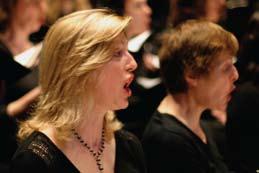
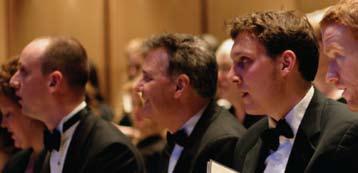
《讓世界每個角落都放聲歌唱》 讓世界每個角落都放聲歌唱 我的上主我的王! 天堂並非高不可攀,
對祂的讚美可以直達雲霄, 大地並不低下卑微,
對祂的讚美可以紮根成長。
讓世界每個角落都放聲歌唱 我的上主我的王! 教堂都要把頌讚的詩篇高聲頌揚, 沒有門能阻隔, 最重要的是,
心靈領受最恆久的喜悅。
讓世界每個角落都放聲歌唱 我的上主我的王!
詞:喬治.赫伯特 場刊中譯:黃家慧
Let all the world in every corner sing
Let all the world in every corner sing, My God and King!
The heavens are not too high, His praise may thither fly:
The earth is not too low, His praises there may grow.
Let all the world in every corner sing, My God and King!
The church with Psalms must shout. No door can keep them out: But above all, the heart Must bear the longest part.
Let all the world in every corner sing, My God and King!
Text by George Herbert
Patron
President
Artistic Director
Associate Chorus Director
Accompanist
Chairman
Choir Manager
女高音 Sopranos
Virginie Appassamy
Tessa Bartley
Sarah Brown
Jenny Clarke
Sheila Cox
Sarah Deane-Cutler
Victoria Ferguson
Alison Flood
Allegra Giagu
Rachel Gibbon
Simone Gregoire
Sally Harrison
Elizabeth Hicks
Karen Jason
Jennifer Kilvert
Laetitia Livesey
Clare Lovett
Irenie Mertzelos
Christine Rush
Beth Schofield
Friesia Schuil
Leanne Singh-Levett
Victoria Smith
Susan Thomas
Isobel Timms
Frances Welch
Laura Westcott
女低音 Altos
Joanna Arnold
Kathleen Butler
Alexis Calice Kessler
Lara Carim
Janik Dale
Margaret Driver
Andrea Easey
Regina Frank
Clare Galton
Kathryn Gilfoy
Roxana Gozzard
Suzanne Healey
Pamela Hewitt
Pamela Hider
Sophy Holland
Erica Howard
Marjana Jovanovic
Andrea Lane
Mary Moore
HRH Princess Alexandra
Sir Roger Norrington
Neville Creed
Matthew Rowe
Iain Farrington
Peter Taylor
Andrew Mackie
Elisabeth Nicol
Angela Pascoe
Nina Richardson
Jennifer Ryall
Christina Stern
Susi Underwood
Mariken Van Dolen
Erika Weingarth
男高音 Tenors
Geir Andreassen
Sam Archer
John Boyne
Kevin Darnell
Jack Dixon
Aloysius Fekete
Jonathan Finn
Iain Handyside
Robert Home
Patrick Hughes
Rhydian Peters
Stephen Pritchard
Paul Thirer
Alexander Thomas
男低音 Basses
Jonothan Bird
Stephen Bonney
Gordon Buky-Webster
Brian Coulstock
Marcus Daniels
Sven Drew
Paul Gittens
Mark Hillier
Martin Hudson
John Luff
Ashley Morrison
William Parsons
Robert Peel
Johannes Pieters
Colin Smith
Peter Sollich
Richard Standish
Greg Thomas
James Torniainen
Dawid Viljoen
Hin-Yan Wong
藝術總監兼總指揮 Artistic Director & Chief Conductor
桂冠指揮 Conductor Laureate
第一小提琴 First Violins
團長 Concertmaster
夏定忠 John Harding
第一副團長 太古贊助 Swire First Associate Concertmaster
梁建楓 Leung Kin-fung
第二副團長 Second Associate Concertmaster
王思恆 Wong Sze-hang
第三副團長
Third Associate Concertmaster
朱蓓 Zhu Bei
毛華 Mao Hua
程立 Cheng Li
鄭之敏 Cheng Chi-man
周立松 Chow Lap-chung
許致雨 Anders Hui
冒異國 Mao Yiguo
梅麗芷 Rachael Mellado
倪瀾 Ni Lan
黃嘉怡 Christine Wong Kar-yee
張希 Zhang Xi
周騰飛 Zhou Tengfei
第二小提琴 Second Violins
●
范丁 Fan Ting
▲
梁文瑄 Leslie Ryang Moon-sun
馬嘉蓮 Katrina Ma
鈴木美矢香 Miyaka Suzuki
冒田中知子 Tomoko Tanaka
戴偉信 William Davidson
方潔 Fang Jie
簡宏道 Ricardo de Mello
何嘉俊 Gallant Ho Ka-chun
李嘉道 Russell Kan Wang-to
巫國暉 Mo Kwok-fai
潘廷亮 Martin Poon Ting-leung
沈榕 Shen Rong
閻宇晴 Alisa Yan Yuqing
何鴻毅家族基金
香港管弦樂團駐團培訓學 員:桂麗、賈丁丁、王亮、
王鵬、夏春雨
The Robert H N Ho Family Foundation Orchestral Fellowships: Gui Li, Jia Ding Ding, Wang Liang, Wang Peng, Xia Chun-yu
中提琴 Violas
● 史嘉圖 Ricardo Zwietisch
▲ 熊谷佳織 Kaori Wilson
黎明 Li Ming
羅舜詩 Alice Rosen
陳誠強 Chan Shing-keung
崔宏偉 Cui Hong-wei
范欣 Fan Yan
洪依凡 Ethan Heath
白明 Pak Ming
孫斌 Sun Bin
王駿 Wang Jun
趙宇 Zhao Yu
何鴻毅家族基金
香港管弦樂團
駐團培訓學員:卜宏
The Robert H N Ho Family Foundation Orchestral Fellowship: Bu Hong
大提琴 Cellos
●
鮑力卓 Richard Bamping
■ 方曉牧 Fang Xiaomu
▲ 林穎 Dora Lam
陳怡君 Chen Yi-chun
關統安 Anna Kwan Ton-an
陳屹洲 Chan Ngat Chau
張明遠 Cheung Ming-yuen
霍添 Timothy Frank
李銘蘆 Li Ming-lu
宋亞林 Yalin Song
何鴻毅家族基金─
香港管弦樂團
駐團培訓學員:張培節
The Robert H N Ho Family Foundation Orchestral Fellowship: Chang Pei-chieh
艾度.迪華特 Edo de Waart
艾德敦 David Atherton
低音大提琴 Double Basses
▲ 姜馨來 Jiang Xinlai
馮榕 Feng Rong
費利亞 Samuel Ferrer
林傑飛 Jeffrey Lehmberg
林達僑 George Lomdaridze
鮑爾菲 Philip Powell
范戴克 Jonathan Van Dyke
薜昱 Xue Yu
長笛 Flutes
● 史德琳 Megan Sterling
▲
謝善栢 Sebastian Jacot
施家蓮 Linda Stuckey
短笛 Piccolo
施家蓮 Linda Stuckey
雙簧管 Oboes
■ 韋爾遜 Michael Wilson
■ 黃錚 Huang Zheng
陳篤信 Christopher Chen
英國管 Cor Anglais
陳篤信 Christopher Chen
單簧管 Clarinets
● 史安祖 Andrew Simon
▲
史家翰 John Schertle
簡博文 Michael Campbell
低音單簧管 Bass Clarinet
簡博文 Michael Campbell
巴松管 Bassoons
● 金瑞 Kam Shui
▲ 李浩山 Vance Lee
崔祖斯 Adam Treverton Jones
低音巴松管 Contra Bassoon
崔祖斯 Adam Treverton Jones
圓號 Horns
● 韋麥克 Mark Vines
■ 羅卓思 Lisa Rogers
▲ 周智仲 Chow Chi-chung
尹洛蔓 May Van Norman
李少霖 Homer Lee Siu-lam
川瀨貴子 Takako Kawase
小號 Trumpets
● 卡拉克 Jonathan Clarke
▲ 莫思卓 Christopher Moyse
華達德 Douglas Waterston
長號 Trombones
● 韋雅樂 Jarod Vermette
韋力奇 Maciek Walicki
低音長號 Bass Trombone
貝爾迪 Michael Priddy
大號 Tuba
● 陸森柏 Paul Luxenberg
定音鼓 Timpani
● 龐樂思 James Boznos
敲擊樂器 Percussion
● 泰貝桑 Shaun Tilburg
梁偉華 Raymond Leung Wai-wa
胡淑徽 Sophia Woo Shuk-fai
豎琴 Harp
● 史基道 Christopher Sidenius
鍵盤 Keyboard
● 葉幸沾 Shirley Ip
● 首席 Principal
■ 聯合首席 Co-Principal
▲ 助理首席 Assistant Principal